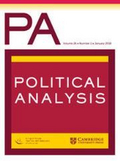Quantifying change over time: interpreting time-varying effects in duration analyses
Ruhe, ConstantinExternal Publications (2018)
in: Political Analysis 26 (1), 90-111
DOI: https://doi.org/10.1017/pan.2017.35
Information
Duration analyses in political science often model nonproportional hazards through interactions with analysis time. To facilitate their interpretation, methodologists have proposed methods to visualize time-varying coefficients or hazard ratios. While these techniques are a useful, initial postestimation step, I argue that they are insufficient to identify the overall impact of a time-varying effect and may lead to faulty inference when a coefficient changes its sign. I show how even significant changes of a coefficient’s sign do not imply that the overall effect is reversed over time. In order to enable a correct interpretation of time-varying effects in this context, researchers should visualize their results with survivor functions. I outline how survivor functions are calculated for models with time-varying effects and demonstrate the need for such a nuanced interpretation using the prominent finding of a time-varying effect of mediation on interstate conflict. The reanalysis of the data using the proposed visualization methods indicates that the conclusions of earlier mediation research are misleading. The example highlights how survivor functions are an essential tool to clarify the ambiguity inherent in time-varying coefficients in event history models.


